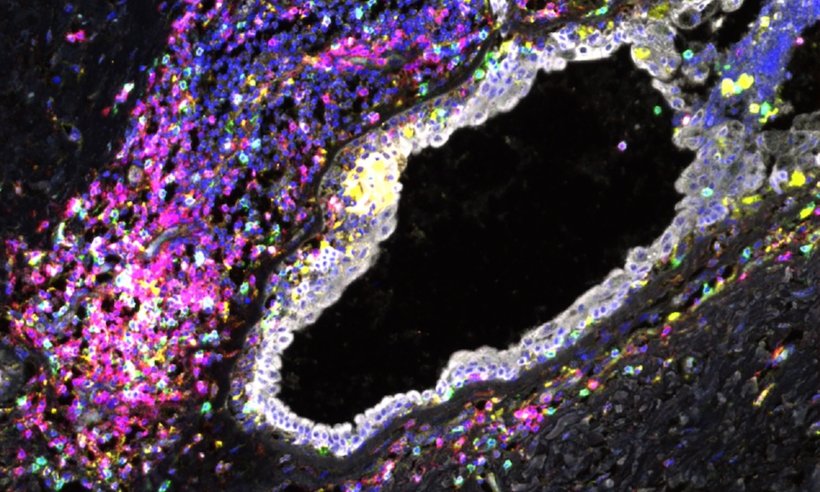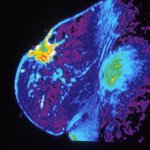
Image credit: Sara Pensa/University of Cambridge
News • BRCA1 and BRCA2 malfunctions
Targeting 'exhausted' immune cells to prevent breast cancer
Researchers at the University of Cambridge have created the world’s largest catalogue of human breast cells, which has revealed early cell changes in healthy carriers of BRCA1 and BRCA2 gene mutations.
Everyone has BRCA1 and BRCA2 genes, but mutations in these genes - which can be inherited - increase the risk of breast and ovarian cancer. The new study, published in the journal Nature Genetics, found that the immune cells in breast tissue of healthy women carrying BRCA1 or BRCA2 gene mutations show signs of malfunction known as ‘exhaustion’. This suggests that the immune cells can’t clear out damaged breast cells, which can eventually develop into breast cancer. This is the first time that ‘exhausted’ immune cells have been reported in non-cancerous breast tissues at such scale - normally these cells are only found in late-stage tumours.
The best way to prevent breast cancer is to really understand how it develops in the first place. Then we can identify these early changes and intervene
Walid Khaled
The researchers have received a ‘Biology to Prevention Award’ from Cancer Research UK to trial this preventative approach in mice. Existing drugs have serious side effects, so testing in mice is necessary to find the right safe dosage. If effective, this will pave the way to a pilot clinical trial in women carrying BRCA gene mutations. “Our results suggest that in carriers of BRCA mutations, the immune system is failing to kill off damaged breast cells - which in turn seem to be working to keep these immune cells at bay,” said Professor Walid Khaled in the University of Cambridge’s Department of Pharmacology and Wellcome-MRC Cambridge Stem Cell Institute, senior author of the report. He added: “We’re very excited about this discovery, because it opens up potential for a preventative treatment other than surgery for carriers of BRCA breast cancer gene mutations. Drugs already exist that can overcome this block in immune cell function, but so far, they’ve only been approved for late-stage disease. No-one has really considered using them in a preventative way before.”
Risk-reducing surgery, in which the breasts are removed, is offered to those at increased risk of breast cancer. This can be a difficult decision for young women to make and can have a significant effect on body image and sexual relationships. “The best way to prevent breast cancer is to really understand how it develops in the first place. Then we can identify these early changes and intervene,” said Khaled. He added: “Late-stage breast cancer tends to be very unpredictable and hard to manage. As we make better and better drugs, the tumours just seem to find a way around it.”
Recommended article

Article • Research, diagnostics, treatments
Focus on breast cancer
Breast cancer (breast carcinoma; often abbreviated as BRCA) is the most common cancer in women in many countries and the cancer with the highest mortality rate. The diagnostic and therapeutic options for breast cancer are correspondingly diverse. Keep reading for latest developments in early detection, staging, treatment and research.
Using samples of healthy breast tissue collected from 55 women across a range of ages, the researchers catalogued over 800,000 cells - including all the different types of breast cell. The resulting Human Breast Cell Atlas is now available as a resource for other researchers to use and add to. It contains huge amounts of information on other risk factors for breast cancer including Body Mass Index (BMI), menopausal status, contraceptive use and alcohol consumption.
“We've found that there are multiple breast cell types that change with pregnancy, and with age, and it’s the combination of these effects - and others - that drives the overall risk of breast cancer,” said Austin Reed, a PhD student in the University of Cambridge’s Department of Pharmacology and joint first author of the report. He added: “As we collect more of this type of information from samples around the world, we can learn more about how breast cancer develops and the impact of different risk factors - with the aim of improving treatment.”
One of the biggest challenges in treating breast cancer is that it is not just one disease, but many. Many different genetic variations can lead to breast cancer, and genetic risk interacts with other risk factors in complicated ways. For example, it is known that the likelihood of breast cancer increases with age, but this risk is greatly reduced by pregnancy early in life. And age-associated risk is greatly increased in carriers of the breast cancer genes BRCA1 and BRCA2.
The new study aimed to understand how some of these risk factors interact, by characterising the different cell types in the human breast under many different physiological states. The researchers used a technique called ‘single cell RNA-sequencing’ to characterise the many different breast cell types and states. Almost all cells in the body have the same set of genes, but only a subset of these are switched on in each cell – and these determine the cell’s identity and function. Single cell RNA-sequencing reveals which genes are switched on in individual cells. “Breast cancer occurs around the world, but social inequalities mean not everyone has access to treatment. Prevention is the most cost-effective approach. It not only tackles inequality, which mostly affects low-income countries, but also improves disease outcome in high-income countries,” said Dr Sara Pensa, Senior Research Associate in the University of Cambridge’s Department of Pharmacology and joint first author of the study.
Source: University of Cambridge
28.03.2024











